Jessica Knauss's Blog
December 28, 2022
Photo of the Year, 2022
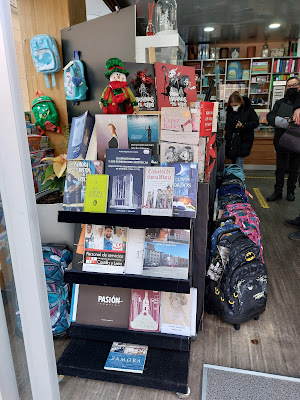 The Photo of 2022 shows that most beautiful sight for any author: one's book in a bookstore.
The Photo of 2022 shows that most beautiful sight for any author: one's book in a bookstore. Specifically, in December of this year, I saw (and snapped a photo) of the Spanish version of my dear short story collection, Our Lady's Troubadour , for sale in the local section, clearly visible from the street, at Mil Hojas Bookstore, Zamora, Spain.
Massive changes in the book industry in the last twenty years have made it frustrating and inconvenient for most authors to see this sight as e-commerce and ebooks overwhelm the printed word. I grew up before the internet (gasp!), and seeing one's book in the store always seemed a glamourous, giant step to authorial stardom.
That kind of deep-seated impression doesn't fade easily, so when I saw my book in my local bookstore, I felt in my blood and bones that this was a beautiful sign of success.
Due to my excitement in sharing this photo with everyone I knew, at least this copy sold. I know because the reader brought it to me to sign, telling me he'd already read it in ebook and was now making a gift of it to his son-in-law. What a tremendously flattering situation for my beloved book!
He went on to say that he couldn't get over how someone not from Spain could think of these things and write them so authentically. Again, so flattering I almost didn't know what to say.
But of course, he'd made a tiny mistake. Everyone at this blog knows my soul is Spanish, right?
This photo, objectively nothing special in itself, has also been chosen as 2022's Photo of the Year because it was taken in 2022 and showcases just one of my publications from 2021.
It can't showcase something from 2022 because no such writing exists.
I've spent all of 2022 working very hard for income to keep a roof over my head and food on the table. I've written two short stories (at the most) that have not been published. Comparison is odious in general, but at the end off 2022, it's hard not to feel like it's come up short.
So, with this photo as inspiration, I'm looking at 2023 head-on to be my best writing year yet. Here's to attaining and surpassing realistic and idealistic goals!
Happy New Year, everybody!
November 23, 2022
The Desire to Touch the Past: The Precursor King Exhibit in Toledo
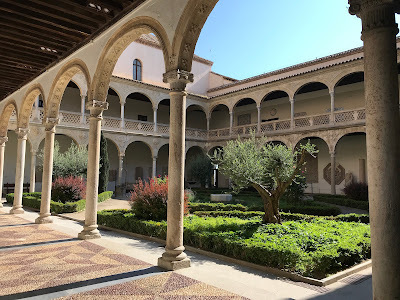 The cloister at the Monastery of Santa Cruz, Toledo,
The cloister at the Monastery of Santa Cruz, Toledo,now the Museum of Santa Cruz
As readers of this blog know, 2021 marked 800 years since the birth of Alfonso X, el Sabio, in Toledo (Spain) on November 23, 1221. I did everything I could to commemorate that important anniversary: going to a concert and exhibits, releasing a book of tremendous importance to me, and presenting that book in Zamora, Burgos, Salamanca, and Benavente.
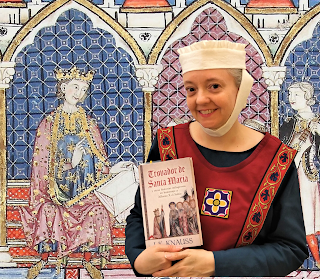 Here we are again on November 23. Happy 801st birthday to the focal point of my scholarly joy!
Here we are again on November 23. Happy 801st birthday to the focal point of my scholarly joy! In May of this year, I had an opportunity to revel in more than 200 objects (pottery, architecture, clothing, manuscripts, recreated musical and scientific instruments, and more!) having to do with Alfonso X, el Sabio, and I think this is an excellent occasion to share some highlights.
I haven't counted, but I think the most celebrations over these two years have taken place in the city of Alfonso's birth. And I have to assume the exhibit Alfonso X: The Legacy of a Precursor King was the most extensive, impressive, and enjoyable.
My mother was with me, and I wore her out looking at everything on offer for a long Spanish morning with excitement that only seemed to increase with every piece. I felt each object in my heart and bones.
The exhibit filled the entire second floor of the Museum of Santa Cruz, and was beautifully organized into moments of Alfonso's life, from birth and family connections, to his early reign, the intellectual projects (the biggest section, of course--we're talking about a certified brainiac), through to the end of his reign, and the impressions of him throughout history since his death in 1284.
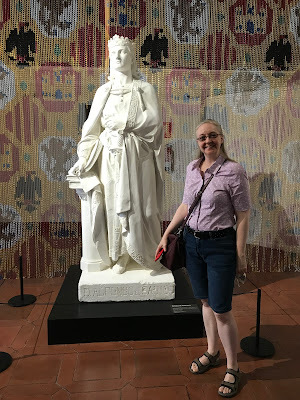 The exhibit started in an anteroom with this lovely model for a nineteenth-century statue that was never completed. I took the opportunity to be photographed with a handsome physical representation of this person I will never meet in life.
The exhibit started in an anteroom with this lovely model for a nineteenth-century statue that was never completed. I took the opportunity to be photographed with a handsome physical representation of this person I will never meet in life. 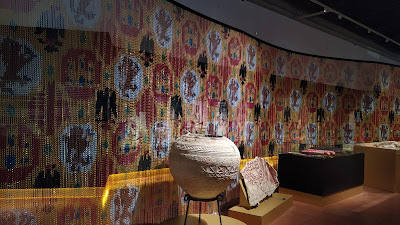 The bead curtains in the background were used throughout the exhibit to separate the sections and highlight the pieces. The intense colors, translucent glow, and symbols of royalty made this visitor feel like she was walking into an Alfonsine manuscript.
The bead curtains in the background were used throughout the exhibit to separate the sections and highlight the pieces. The intense colors, translucent glow, and symbols of royalty made this visitor feel like she was walking into an Alfonsine manuscript.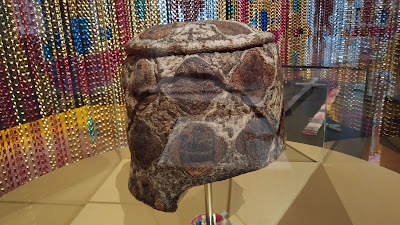 One representative of Alfonso's early family life was his brother, Prince Felipe. This linen and silk bonnet was removed from his tomb in Villalcázar de Sirga. The colors have darkened over time, but the castles and lions, emblems of the prince's royal status, are still visible.
One representative of Alfonso's early family life was his brother, Prince Felipe. This linen and silk bonnet was removed from his tomb in Villalcázar de Sirga. The colors have darkened over time, but the castles and lions, emblems of the prince's royal status, are still visible. When you work mainly with texts, your heroes are ephemeral collections of thoughts and ideas. Anything that gives evidence of that hero's physical existence, even if it was 800 years ago, is the closest thing we have to traveling in time.
Closed tombs, architecture where they lived, or pottery they might've used become a concentrated blast of emotion accumulated over years of study. If possible, clothing is an even more intense sensory experience.
Clothing so rarely survives because it's so delicate, and it is one of the most intimate things any person will ever use. Being so close I could touch the threads and smell the earthiness of the silk and metallic gold, and imagining this very hat on the head of Alfonso's brother... and ones just like it on the head of the king himself... Simply overwhelming.
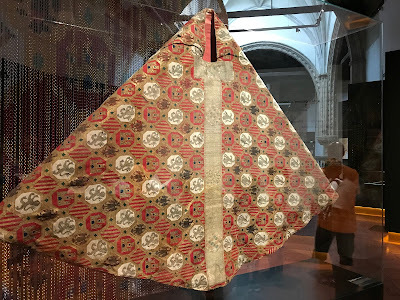 Unlike the hat, this cape retains all its original splendor. Probably a gift from Alfonso X to his brother-in-law, Prince Sancho, when Sancho was made Archbishop of Toledo (the most important ecclesiastical role in medieval Spain), the cape's silk and gold threads show the symbols of Castile and León (Alfonso's kingdom), Aragón (Prince Sancho's kingdom of origin), and the eagle of the Staufen family in memory of Alfonso's mother, Beatriz of Swabia.
Unlike the hat, this cape retains all its original splendor. Probably a gift from Alfonso X to his brother-in-law, Prince Sancho, when Sancho was made Archbishop of Toledo (the most important ecclesiastical role in medieval Spain), the cape's silk and gold threads show the symbols of Castile and León (Alfonso's kingdom), Aragón (Prince Sancho's kingdom of origin), and the eagle of the Staufen family in memory of Alfonso's mother, Beatriz of Swabia. 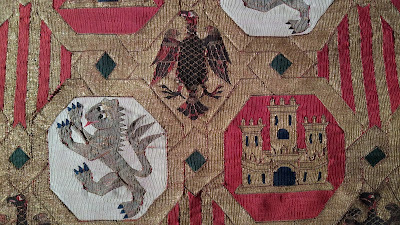 This closeup shows itsintricate detail and solid embroidery. It had to have been created by a team of royal tapestry-makers, and it's so intact, it must hardly have been used and been stored in very fortunate conditions. The bead curtains we were "wrapped" in the whole time are based on this pattern.
This closeup shows itsintricate detail and solid embroidery. It had to have been created by a team of royal tapestry-makers, and it's so intact, it must hardly have been used and been stored in very fortunate conditions. The bead curtains we were "wrapped" in the whole time are based on this pattern. 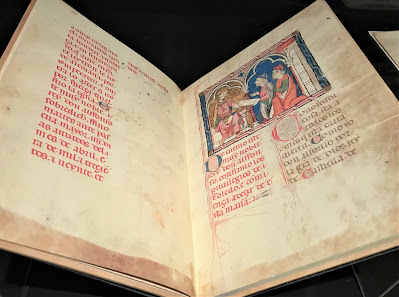 The Book of the Privileges of Toledo, late thirteenth century, is a deluxe manuscript to ensure no one forgot exactly what rights and benefits Toledo had from the king. The miniature shows Alfonso X granting these privileges to grateful Toledans, yet another representation of the king doing his job with due generosity.
The Book of the Privileges of Toledo, late thirteenth century, is a deluxe manuscript to ensure no one forgot exactly what rights and benefits Toledo had from the king. The miniature shows Alfonso X granting these privileges to grateful Toledans, yet another representation of the king doing his job with due generosity. 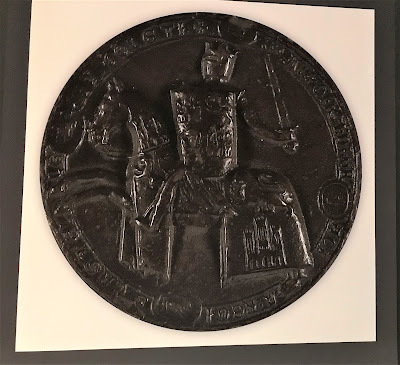 I have a cherished replica of this seal at my home in the United States. In the Middle Ages, seals of authentication were large and hung from the documents by a cord. This wax seal is as big as the palm of an "average" man's hand and shows Alfonso X riding into battle.
I have a cherished replica of this seal at my home in the United States. In the Middle Ages, seals of authentication were large and hung from the documents by a cord. This wax seal is as big as the palm of an "average" man's hand and shows Alfonso X riding into battle. Medieval Spanish kings were expected to be able warriors and participate in whatever important battles came up. Though we no longer emphasize this aspect when remembering him, Alfonso X took active part in many battles, including helping his father win important cities in the south while he was still prince. His declining health in later years and extraordinary intellectual accomplishments are what people emphasize about him. Every once in a while it's good to recall that Alfonso X never shirked his physical duties, either.
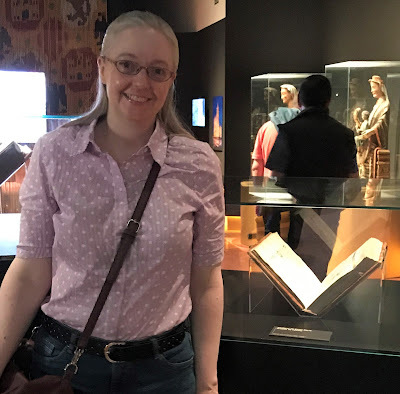 Here I am with the To codex of the Cantigas de Santa Maria. Remember what I wrote about clothing being so personal? In Alfonso X's case, Cantigas manuscripts, which he definitely commissioned, may have edited and approved, and certainly physically touched to refer to when complete, are probably the most personal physical object possible.
Here I am with the To codex of the Cantigas de Santa Maria. Remember what I wrote about clothing being so personal? In Alfonso X's case, Cantigas manuscripts, which he definitely commissioned, may have edited and approved, and certainly physically touched to refer to when complete, are probably the most personal physical object possible. The only reason my head didn't explode at this point was that I had already seen this very codex in February in Madrid at the National Library. That day I saw so many of the manuscripts I've spent decades admiring from afar that I broke down sobbing for a few minutes. With that out of the way, in May I had emotional space to take in this manuscript again and all the new-to-me wonders, as well. It's an accomplishment!
The To codex was open to a different page for this exhibit than it had been in Madrid. Significantly, it displayed Cantiga 12, which takes place in Toledo.
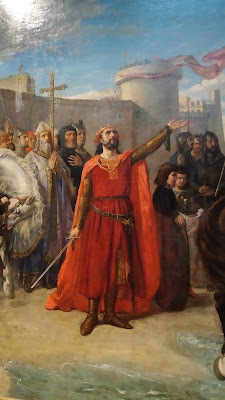 Alfonso X enters Cádiz and takes possession of the sea in this lively nineteenth-century painting that won the artist, Matías Moreno, a gold medal. This painting was at the entrance to the document-heavy section of the exhibit, so perhaps it served to remind visitors that these documents are not merely dry ink on vellum. They depict exciting events, many of which had centuries-long repercussions.
Alfonso X enters Cádiz and takes possession of the sea in this lively nineteenth-century painting that won the artist, Matías Moreno, a gold medal. This painting was at the entrance to the document-heavy section of the exhibit, so perhaps it served to remind visitors that these documents are not merely dry ink on vellum. They depict exciting events, many of which had centuries-long repercussions. 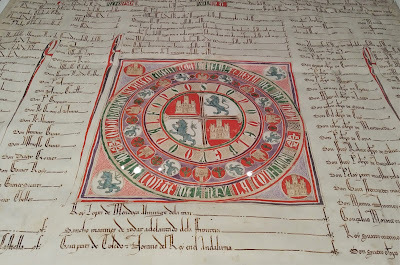 Many legal documents display these beautiful circular symbolic royal signatures for a validation that's obvious to anyone who looks at it. This royal circle, especially deluxe with its rich reds, greens, black, and gold, is from a May 24, 1256, privilege granting coin minting to the archbishop and council of the Cathedral of Toledo.
Many legal documents display these beautiful circular symbolic royal signatures for a validation that's obvious to anyone who looks at it. This royal circle, especially deluxe with its rich reds, greens, black, and gold, is from a May 24, 1256, privilege granting coin minting to the archbishop and council of the Cathedral of Toledo.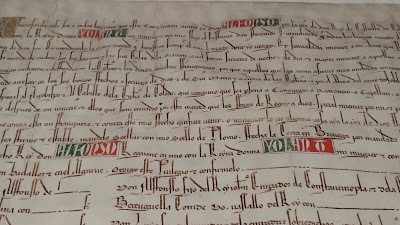 A closeup of the same document shows the king and queen's names highlighted in green and red. I have a feeling I'll be discussing Queen Violante more on this blog in the coming months.
A closeup of the same document shows the king and queen's names highlighted in green and red. I have a feeling I'll be discussing Queen Violante more on this blog in the coming months. 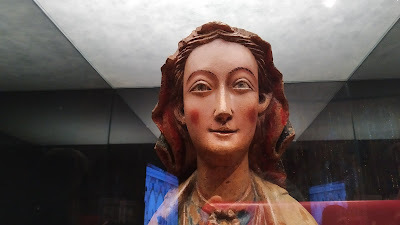 A painted wooden St. Mary of the Navarra school, late thirteenth century, is a three-dimensional example of the aesthetic found throughout the Alfonsine manuscripts.
A painted wooden St. Mary of the Navarra school, late thirteenth century, is a three-dimensional example of the aesthetic found throughout the Alfonsine manuscripts. 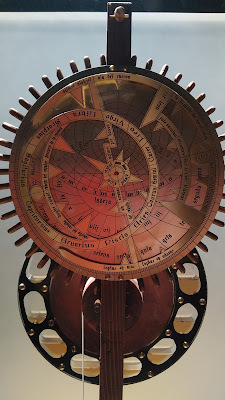 In the astronomy section, some of the most impressive pieces were reconstructions of the instruments described and illustrated in the Alfonsine books that measure the phenomena of the night sky. Eduard Farré recreated this Mercury clock, which shows the movement of the constellations, based on the Book of Knowledge of Astrology.
In the astronomy section, some of the most impressive pieces were reconstructions of the instruments described and illustrated in the Alfonsine books that measure the phenomena of the night sky. Eduard Farré recreated this Mercury clock, which shows the movement of the constellations, based on the Book of Knowledge of Astrology.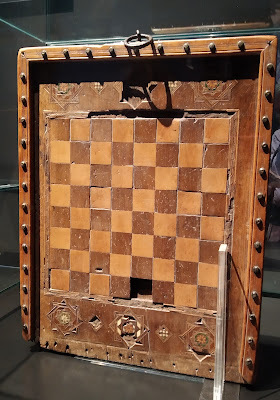 The most diligent intellectuals are the people most in need and deserving of taking a little break now and then. This philosophy is found at the beginning of the Book of Chess and Board Games (1283), the last book Alfonso X commissioned. This chessboard from fourteenth-century Granada looks like it came out of an illustration from that book. It's practical, with storage for the pieces and a way to secure and carry it wherever it's needed for some clean fun.
The most diligent intellectuals are the people most in need and deserving of taking a little break now and then. This philosophy is found at the beginning of the Book of Chess and Board Games (1283), the last book Alfonso X commissioned. This chessboard from fourteenth-century Granada looks like it came out of an illustration from that book. It's practical, with storage for the pieces and a way to secure and carry it wherever it's needed for some clean fun. 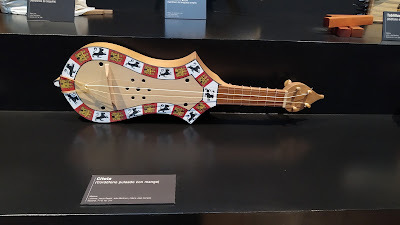 The exhibit boasted an enormous altar of musical instruments recreated from illustrations in the Cantigas manuscripts. Jesús Reolid, Jota Martínez, and María José Campos crafted this lovely citole, accurate down to the castles and lions.
The exhibit boasted an enormous altar of musical instruments recreated from illustrations in the Cantigas manuscripts. Jesús Reolid, Jota Martínez, and María José Campos crafted this lovely citole, accurate down to the castles and lions. 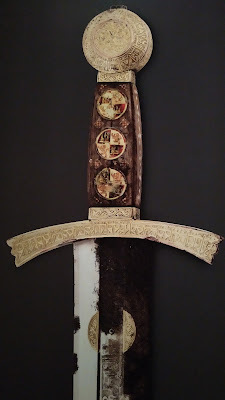 After a somber section describing Alfonso X's difficult final years and death, but that also provided a video summary of his accomplishments, the exhibit featured what turned out to be the star items. When they opened the tomb of Sancho IV, Alfonso's second son and successor, in 1947, the scholars rescued many items Sancho had been buried with. The first on display was this spectacular sword.
After a somber section describing Alfonso X's difficult final years and death, but that also provided a video summary of his accomplishments, the exhibit featured what turned out to be the star items. When they opened the tomb of Sancho IV, Alfonso's second son and successor, in 1947, the scholars rescued many items Sancho had been buried with. The first on display was this spectacular sword. I don't think I would be so into medieval Spain or swords if I hadn't adored The Princess Bride as a preteen. This kind of thing still has plenty of capacity to delight me. This sword is regally decorated and must have rested in Sancho's hand on any number of occasions. It's another very personal item for that reason.
 The piece I had been longing to see came at the end. Another item extracted from Sancho's tomb, this is the only medieval Spanish king's crown that we are aware of having survived to the present day. The only one! And it seems extraordinary.
The piece I had been longing to see came at the end. Another item extracted from Sancho's tomb, this is the only medieval Spanish king's crown that we are aware of having survived to the present day. The only one! And it seems extraordinary. I love the ingenious way the castles serve as the peaks. There's no pictorial evidence that this was the usual way to design a crown. The large precious stones, however, are typical. The cameos aren't a medieval specialty, but it was very medieval to repurpose Roman cameos. I think these cameos were probably already antique when they were set into the crown. The hinges so it could adapt to different heads and headwear are another delightful surprise. The king would've worn a soft hat, often of velvet, and placed this crown on top.
Here's the thing. Though it was found in Sancho's tomb, it's pretty clear Alfonso X used this crown before his son did. Alfonso's 1282 testament granted his heir "the crown with stones and cameos." Most scholars agree it makes sense that he's referring to this crown, the only one that survived the Middle Ages to our time.
I would've bought a reasonably accurate replica of this crown, no questions asked, no matter the cost. Even though I had no room in my suitcase after my mom had brought me a couple of things from the United States and three weeks of travel. Even though I have nowhere to put it in my apartment. I would've found a place.
But no replica was available, and so I went home with just a great CD of Cantigas by the Jota Martínez Ensemble.
 Granular closeup of a bejeweled sheath said to accompany a
Granular closeup of a bejeweled sheath said to accompany a sword belonging to "Roland." Since it's from 1250 and part
of the royal treasury, it's likely Alfonso X, his father, and his son
were the actual owners of this sword.
After a wonderful visit, I've been reading about the Romanesque art of the cathedral of Santiago de Compostela. Maestro Mateo, the designer, was kind enough to sculpt a near-life-size statue of Santiago the pilgrims could approach and wrap their arms around. In this way, they tangibly experienced the object of a devotion so strong, they left their homes and walked for months in its honor.
This was nearly a thousand years ago, so it has nothing to do with modern commercialism, but with a deep-seated need for humans to bring their interior hopes and dreams into exterior reality.
I've left the place of my birth and have been on this Alfonsine journey much longer than it takes to walk the Camino de Santiago. Of course I want tangible evidence of my decades of study. The Precursor King exhibit has been the event that came closest to fulfilling that desire.
But I wasn't able to literally touch any of the books, clothing, instruments, or metalwork. The saga continues...
Thanks for letting me share a small part of my joy with you.
Further reading:
Our Lady's Troubadour
Law and Order in Medieval Spain
September 23, 2022
New Historical Fiction: The Last Dollar Princess by Linda Bennett Pennell
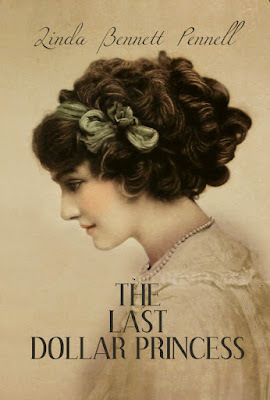
It must be said. Scandal follows her family like a faithful hound. No matter how hard they kick it away, it comes slinking around to insinuate itself into their lives again. Although her family is obsessed with social position, one thing is certain. Heiress India Elisabeth Petra De Vries Ledbetter is an outlier among her kin. She is determined to set her own course, family expectations and society's demands be damned.
Reared away from the social whirl of Gilded Age New York, India would prefer a life of philanthropy in her native Appalachia, but Mother and Grandmama have far grander plans. They believe Mrs. Astor’s old 400 are ready to overlook the past and that an advantageous marriage will cement their place in society once more. In fact, they have already selected the prospective bridegroom. The only problem? No one consulted India.
With captivating insights into the human spirit and heart, The Last Dollar Princess leads us on a riveting quest for self-determination through the most elegant and glamorous settings of the early 20th century. Perfect for fans of Marie Benedict, Daisy Goodwin, and Julian Fellows, this sweeping work of historical fiction will stay with readers long after the last page is turned.

Linda Bennett Pennell has been in love with the past for as long as she can remember. Anything with a history, whether shabby or majestic, recent or ancient, instantly draws her in. It probably comes from being part of a large extended family that spanned several generations. Long summer afternoons on her grandmother's wrap around porch or winter evenings gathered by the fireplace were filled with stories both entertaining and poignant. Of course, being set in the American South, those stories were also peopled by some very interesting characters, some of whom have found their way into Linda’s work.
As for her venture in writing, it has allowed Linda to reinvent herself. We humans are truly multifaceted creatures, but unfortunately we tend to sort and categorize each other into neat, easily understood packages that rarely reveal the whole person. Perhaps you, too, want to step out of the box in which you find yourself. Linda encourages you to look at the possibilities and imagine. Be filled with childlike wonder in your mental wanderings. Envision what might be, not simply what is. Never forget that all good fiction begins when someone says to her or himself, "Let's pretend."
Linda resides in the Houston, Texas, area with one sweet husband and one adorable Labradoodle who is quite certain she’s a little girl.
"History is filled with the sound of silken slippers going downstairs and wooden shoes coming up." --Voltaire
September 22, 2022
World Rhino Day 2022

One great thing about the pandemic was the decrease in rhino poaching incidents. Now, COVID-19 is considered to be under control in most places in the world, and along with all the great stuff that implies, poaching incidents are on the rise.
For those who don't know, rhinos are hunted for their horns because some people wrongly believe that these special horns have a few different medicinal properties and will pay hefty sums for them.
No. The only one who needs a rhino horn is a rhino. A rhino horn is made of plain old keratin you can find in many other places. You might as well chew your own fingernails,
But greed and wrongheaded ideas are evergreen.
Please think about how wonderful these five species of gentle giants are for their respective environments, how few of them are left, and how sad it would be if there were no more of them.
I'm writing this post before the twenty-second, but you'll be able to catch up with the State of the Rhino Report and lots of fun activities at rhinos.org.
Thank you!
September 13, 2022
Thirteenth Anniversary

Today marks thirteen years since I married Stanley Arthur Coombs. Thirteen was our number: We met on a thirteenth and married on a different thirteenth the following year. We mentioned, at the very least, that it was our day on the thirteenth of every month we were together.
I wrote some solid things that are still true for our tenth anniversary on this blog, and I don't want to repeat myself. I'll use this space to say that Stanley died in 2016, so this anniversary marks a moment in time when I've survived him almost as long as I was married to him. We only missed celebrating our seventh anniversary together by a month and half, so the marriage still wins by a few months at this point, but the symmetry being so close on "our number" anniversary seems significant to me.
If you know that Stanley was twenty-four years older than me, you might wonder why I was so blindsided that he predeceased me by so many years.
He always seemed healthy and youthful. The world was a place of new experiences and ceaseless wonder for him. He was never old. His parents also both lived well into their eighties, and I figured he must've inherited some longevity, and we had at least twenty more years ahead of us in 2016.
I'd forgotten that he'd smoked a pack a day for forty years before he met me.
It was easy to forget because as soon as I mentioned that I didn't appreciate smoking, he quit. I never saw him with a cigarette.
If only the cells in his lungs could've forgotten so easily!
Our short years together compacted an insane amount of love and joy. We did everything right, from finding each other at long last, to not waiting long to marry, to wandering all around the United States and Spain, enjoying life on Earth in all its complexity.
Our relationship changed to the nonphysical realm too quickly. Tobacco companies stole some two decades from us. Stanley always said, "You gotta die from something." It's true, but I can't help but think that something so stupid and preventable was unworthy of my wonderful husband.
It was too late by the time I met him.
It may not be too late for you.
The present moment is all we have.
August 1, 2022
Brand New (Oddio) Audiobooks to Enjoy! Y una nueva edición muy guay
I've always known my books are mostly odd, so it only makes sense that they should be available in oddio audio. I'm so excited that this dream is now finally coming true! I've decided to reach readers through their ears instead of their eyes!

The first book is a medieval classic prepared for you with modern technology, my translation, The Abencerraje .
Listen here.
This short story (it will take you less than an hour to listen to) was written in Spanish in the 1560s, and it will surprise you with its depth of feeling and its powerful message about the value of human life and especially of friendship.
The Abencerraje is a popular text in Spanish literature survey courses at the university level, and I've also completed this project in the spirit of helping out a few students.
More amazing audiobooks are on their way! Feel free to subscribe to my YouTube channel so you never miss another one.
These texts are read by yours truly. What I lack in professional locution skills, I hope to make up for in enthusiasm and drama.
 Grab your copy of the extraordinarily entertaining historical novella,
Empress of Misfortune
:
Grab your copy of the extraordinarily entertaining historical novella,
Empress of Misfortune
: - available at select outlets
- FREE only to my email subscribers
It's coming out in paperback and audiobook read by the author very soon!

The audiobook magic continues in my other genre! The second book, releasing today, is the sweet, fun science fantasy novella The Atwells Avenue Anomaly. I'm so excited to bring this original story to readers in this new format!
Watch/listen here.
If you're in a massive heat wave like I am, The Atwells Avenue Anomaly can help you cool off. It takes place in Providence, Rhode Island, in the autumn, and also in another universe that never has unpleasant weather!

Next up in audiobook is the always controversial women's novella, Tree/House . This one is read by a professional! Look for it in September on my channel!
And again, I would be grateful if you subscribed to my channel so you can always have access to surprising, memorable stories.
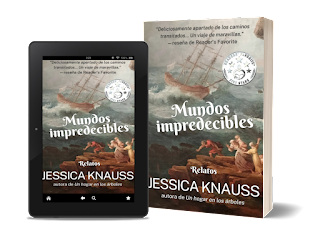
Y por último, quizás lo más importante: Mundos impredecibles , mi colección de relatos que consistentemente alcanza cinco estrellas de sus lectores satisfechos, ya aparece en una nueva edición. ¡Ahora ya se puede adquirir en rústica! Ver toda la información aquí.
Thank you for letting me share my hard work and excitement with you!
July 18, 2022
950 Years Later, the Siege of Zamora
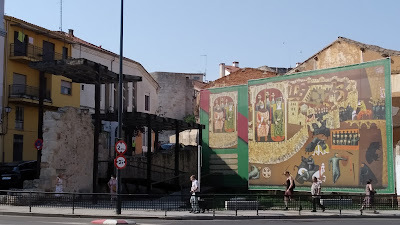 This mural by beloved Zamoran artist Antonio Pedrero
This mural by beloved Zamoran artist Antonio Pedrero graphically represents the Siege of Zamora
at the Puerta de la Feria (not far from my house).
This year marks the 950th anniversary of Zamora's most famous moment in history, the Siege of Zamora. If you've seen the El Cid film, this story occupies the first part. That is by far not the only medium this epic story has found it way into, with plays, songs, poems, and visual art existing almost since the time of its occurrence in 1072.
This weekend (the hottest on record), the city government sponsored the revival of a play by Agustin Garcia Calvo, just one of many events marking this anniversary. The production by contra-tiempo-teatro and many collaborators was brought to life with modern spectacle and a heavy dose of charm. I thought using photos from the event would be a great way to tell this story on my humble blog.
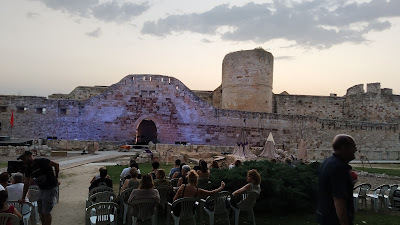 The sun sets behind the castle, a very evocative setting for the story of the siege of Zamora.
The sun sets behind the castle, a very evocative setting for the story of the siege of Zamora. 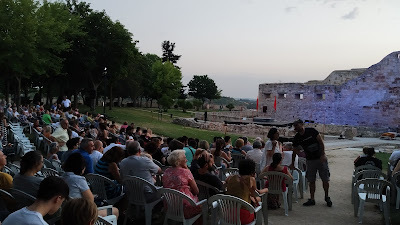 It was necessary to reserve tickets days in advance. These cultural events are very popular in Zamora.
It was necessary to reserve tickets days in advance. These cultural events are very popular in Zamora. 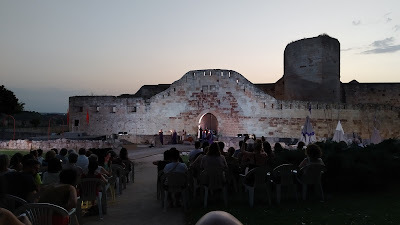 The actors and musicians arrive on the scene. The play was very medieval in that most of it was narrated by a pair of singers and a vihuela, a medieval stringed instrument. Both the sung lyrics and spoken parts were in medieval epic meters with rhyme.
The actors and musicians arrive on the scene. The play was very medieval in that most of it was narrated by a pair of singers and a vihuela, a medieval stringed instrument. Both the sung lyrics and spoken parts were in medieval epic meters with rhyme. I often wonder why Spanish historical fiction feels no need to update the mode of delivery of the content. If I were writing a play about the Siege of Zamora, I would never think to use narrators, but would reveal all the complex story through action and dialogue with psychological development. But that's my Anglophone historical fiction perspective. This way of doing things pleases the audience because it's "more medieval," and that's what counts.
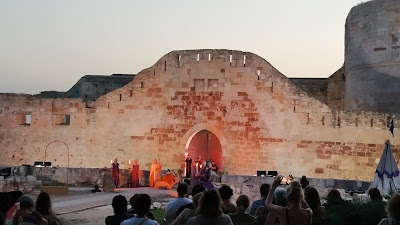 The action begins with King Fernando I on his death bed, dividing up his kingdoms. To Sancho goes Castile, Alfonso receives Leon, and to Garcia goes Galicia.
The action begins with King Fernando I on his death bed, dividing up his kingdoms. To Sancho goes Castile, Alfonso receives Leon, and to Garcia goes Galicia. 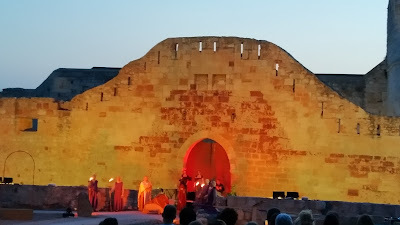 Fernando I's daughter Urraca arrives on the scene to say more or less, "What am I, chopped liver?" Of course she isn't. The king grants her the noble and strategic city of Zamora to govern. She becomes our "Queen." We love her even today.
Fernando I's daughter Urraca arrives on the scene to say more or less, "What am I, chopped liver?" Of course she isn't. The king grants her the noble and strategic city of Zamora to govern. She becomes our "Queen." We love her even today. 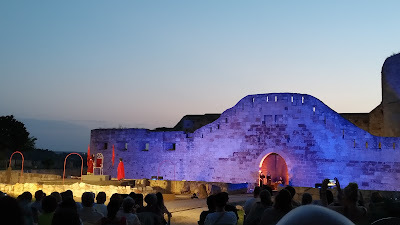 Fernando I is dead. Urraca is offered the throne in Zamora, but she says, "Why sit down? Sancho's just going to push me off again!" Indeed, Sancho, not satisfied with the biggest piece of the pie, Castile, wants his siblings' pieces, too. He's taken control of Galicia and Leon and imprisoned his brother, Alfonso.
Fernando I is dead. Urraca is offered the throne in Zamora, but she says, "Why sit down? Sancho's just going to push me off again!" Indeed, Sancho, not satisfied with the biggest piece of the pie, Castile, wants his siblings' pieces, too. He's taken control of Galicia and Leon and imprisoned his brother, Alfonso. 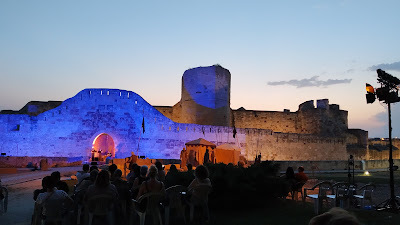 Sancho's forces set up tents in order to lay siege to Zamora. It was very cool to watch the actors actually put up the tents.
Sancho's forces set up tents in order to lay siege to Zamora. It was very cool to watch the actors actually put up the tents. 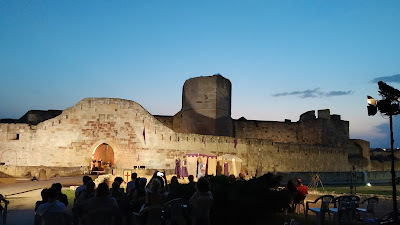 Sancho asks his knight El Cid (yes, that one!) to ask Urraca to hand over Zamora so they don't have to start the siege. El Cid and Urraca know each other pretty well. If anyone can convince her, he can.
Sancho asks his knight El Cid (yes, that one!) to ask Urraca to hand over Zamora so they don't have to start the siege. El Cid and Urraca know each other pretty well. If anyone can convince her, he can. 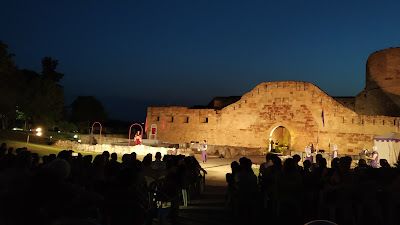 El Cid arrives on his valiant steed (a terribly cute and expressive stuffed animal). In no version of this legend does Urraca ever simply hand over Zamora. Come on!
El Cid arrives on his valiant steed (a terribly cute and expressive stuffed animal). In no version of this legend does Urraca ever simply hand over Zamora. Come on! 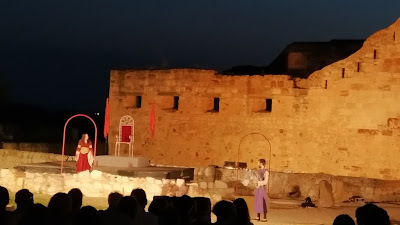 In this version, she says, more or less, "You had your chance to marry me, and you didn't take it. You're not the boss of me, and I'll never surrender Zamora!"
In this version, she says, more or less, "You had your chance to marry me, and you didn't take it. You're not the boss of me, and I'll never surrender Zamora!"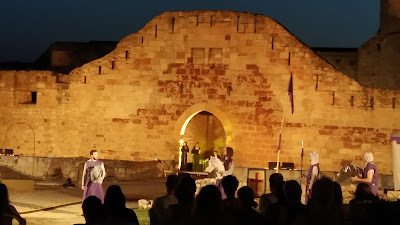 El Cid tells Sancho's other knights, "I knew that wouldn't work. Let's start the siege." Zamora lasts for eight or nine months without budging.
El Cid tells Sancho's other knights, "I knew that wouldn't work. Let's start the siege." Zamora lasts for eight or nine months without budging. 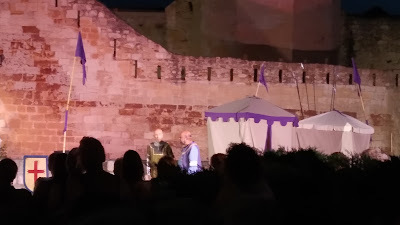 Vellido Dolfos, formerly a knight of King Alfonso, confers with Urraca without ever implicating her in his plans in this version. He then insinuates himself into Sancho's camp under false pretenses of bringing solid intelligence about where to attack Zamora's impenetrable walls.
Vellido Dolfos, formerly a knight of King Alfonso, confers with Urraca without ever implicating her in his plans in this version. He then insinuates himself into Sancho's camp under false pretenses of bringing solid intelligence about where to attack Zamora's impenetrable walls. In short order, he assassinates King Sancho, bringing a quick end to the siege and the fratricidal war. Alfonso is now the only brother left.
 Another of Sancho's best knights, significantly more hotheaded than El Cid, accuses Zamora (in the person of Arias Gonzalo) of Sancho's death. And I mean he accuses all of Zamora, enumerating the women, children, dogs, and chickens as conspirators.
Another of Sancho's best knights, significantly more hotheaded than El Cid, accuses Zamora (in the person of Arias Gonzalo) of Sancho's death. And I mean he accuses all of Zamora, enumerating the women, children, dogs, and chickens as conspirators. Arias Gonzalo explains calmly that he cannot bring a formal complaint against every last living thing in Zamora.
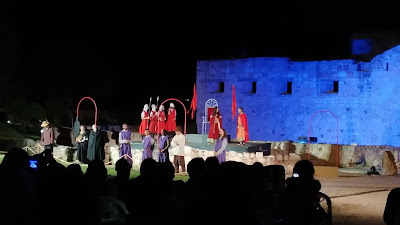 Consulting with Urraca, Arias Gonzalo sets up a trial by combat. If Sancho's knight beats each of five Zamoran knights in single combat, then his accusation is true, and Zamora must pay further. If Sancho's knight falls, however, his accusation is false. The five Zamoran knights are Arias Gonzalo's four sons and himself.
Consulting with Urraca, Arias Gonzalo sets up a trial by combat. If Sancho's knight beats each of five Zamoran knights in single combat, then his accusation is true, and Zamora must pay further. If Sancho's knight falls, however, his accusation is false. The five Zamoran knights are Arias Gonzalo's four sons and himself.  These were some really cool action sequences I couldn't capture very well.
These were some really cool action sequences I couldn't capture very well. Sancho's knight beats the first two sons of Arias Gonzalo. But then son number three defeats Sancho's knight by hook or by crook. The arbiters of the process, the Knights of Santiago, decide that this outcome leaves the trial inconclusive. So much like real life.
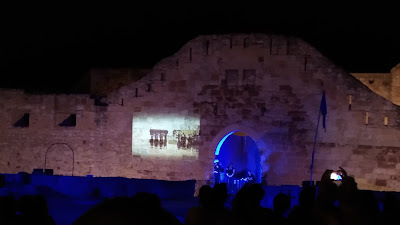 The funeral procession for King Sancho is projected on the castle wall.
The funeral procession for King Sancho is projected on the castle wall. 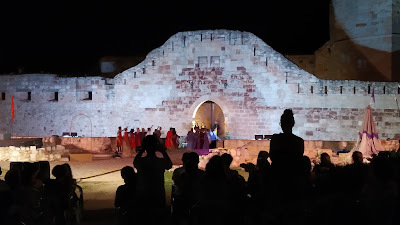 The actors take their bows to thunderous applause.
The actors take their bows to thunderous applause. The last lines in the play are spoken by El Cid on his way to meet King Alfonso as he rides away from Zamora. He says some lovely things about how strong it is and wishes the city well, knowing that it will endure for many, many centuries. At first I thought the audience was clapping for what he said because they love Zamora, too. But no, the play was over at that point. The story stopped at a place ripe for more epic action, as we see in the El Cid film. But, since it was titled The Siege of Zamora, it delivered on its promise, and nothing more.
This story certainly needs a good historical novel in the Anglophone tradition. I'm trying to start something else right now, so consider the gauntlet thrown. Alternatively, if one exists and I just haven't read it, feel free to let me know about it!
February 16, 2022
The Exhibits I Waited 800 Years to See
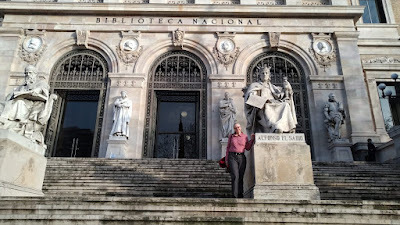 Me and the most important men of letters of Spain
Me and the most important men of letters of SpainI wrote Our Lady's Troubadour for Alfonso X's 800th birthday. I was largely under the impression that most celebrations had been canceled or curtailed by the pandemic. But, wonder of wonders, the two most appropriate institutions in Spain recently had exhibits in honor of this grand anniversary.
The exhibits were appropriate because Alfonso was the Learned King, and the exhibits were of his books: the books he had his scholars research, write, lay out, and decorate in his court, and which he would've inspected to make sure they were to his standard and then left for future generations in his testament. Those books.
The places housing the exhibits were appropriate because they're the two most important libraries in Spain. Even the humblest of libraries is a temple of learning. These buildings, with their grandeur and special designs for preserving and honoring books, are cathedrals of learning.
My new knight in shining armor and I have been crazy busy, but when I saw that these once-in-a-millennium exhibits were about to end, we made a special trip, right around Valentine's Day. Books = Love.
First, "The Books of the Wise King" at the National Library of Spain in Madrid.
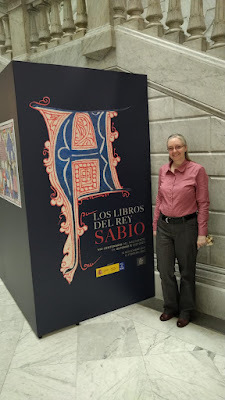 That illuminated A... I would wear a shirt with that on it!
That illuminated A... I would wear a shirt with that on it! 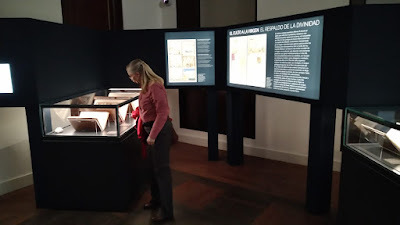 The mask keeps the drool from hitting the glass cases. 😉 Yours truly with the To codex of the Cantigas de Santa Maria.
The mask keeps the drool from hitting the glass cases. 😉 Yours truly with the To codex of the Cantigas de Santa Maria. 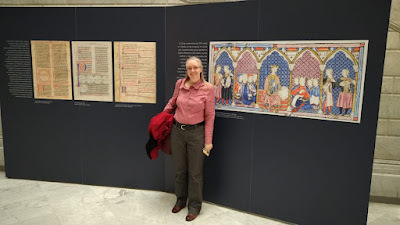 Just flipping out with a display of the E codex Cantigas presentation miniature. I'm practically in Alfonso's colorful court!
Just flipping out with a display of the E codex Cantigas presentation miniature. I'm practically in Alfonso's colorful court! 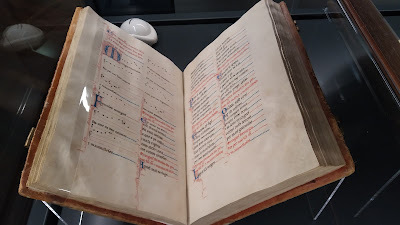 What we all came for right up front: the To codex of the Cantigas de Santa Maria, produced at the court of Alfonso X and personally approved by the king. With about 100 cantigas, it's considered to be the first part of a project that just kept growing.
What we all came for right up front: the To codex of the Cantigas de Santa Maria, produced at the court of Alfonso X and personally approved by the king. With about 100 cantigas, it's considered to be the first part of a project that just kept growing. I can't emphasize enough that these books are deluxe and that it's a miracle we can decipher the musical notation today and enjoy these beautiful songs. The manuscript is open to Cantiga 37, a miracle about a man whose foot hurt so much he cut it off. The foot was replaced when he asked St. Mary for help.
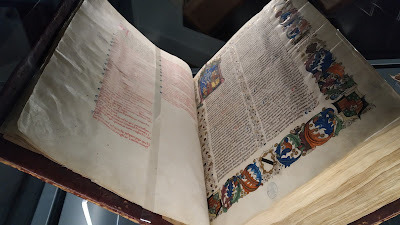 The greatest law treatise of Alfonso's court, the Siete Partidas, this time in a copy for Queen Isabel I. I studied this and other law treatises for my doctoral dissertation. The confidence and clarity with which these scholars wrote in a language that had only been written down officially for about fifty years is stunning.
The greatest law treatise of Alfonso's court, the Siete Partidas, this time in a copy for Queen Isabel I. I studied this and other law treatises for my doctoral dissertation. The confidence and clarity with which these scholars wrote in a language that had only been written down officially for about fifty years is stunning. 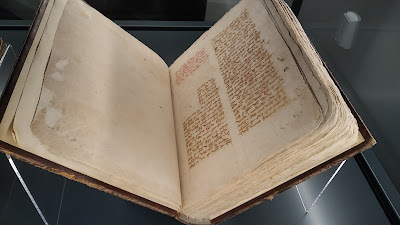 The other great law treatise, the Especulo, predecessor of the Siete Partidas, in a copy from the fourteenth century, which is the only medieval copy the National Library has.
The other great law treatise, the Especulo, predecessor of the Siete Partidas, in a copy from the fourteenth century, which is the only medieval copy the National Library has.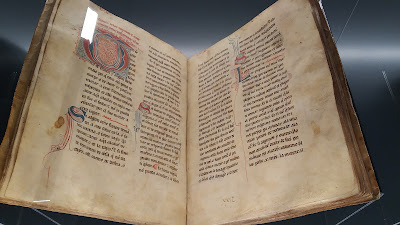 A beautiful codex of the Fuero Real, a royally sanctioned municipal law code. This one was granted to Valladolid in 1255, just three years into Alfonso's reign.
A beautiful codex of the Fuero Real, a royally sanctioned municipal law code. This one was granted to Valladolid in 1255, just three years into Alfonso's reign. 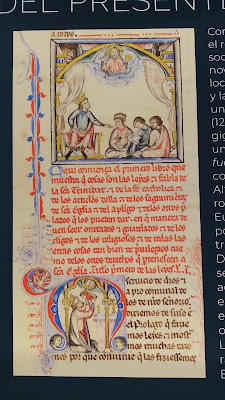 Display of the presentation miniatures of a codex of the first Partida that is held in the British Library. I'd only ever seen black-and-white reproductions before. Unlike traditional medieval European presentation miniatures, instead of a scribe presenting a completed book to the person who asked for it to be copied (usually a king), here King Alfonso dictates the contents of the book and looks overhead at the book's inspiration and eventual recipient: God.
Display of the presentation miniatures of a codex of the first Partida that is held in the British Library. I'd only ever seen black-and-white reproductions before. Unlike traditional medieval European presentation miniatures, instead of a scribe presenting a completed book to the person who asked for it to be copied (usually a king), here King Alfonso dictates the contents of the book and looks overhead at the book's inspiration and eventual recipient: God. 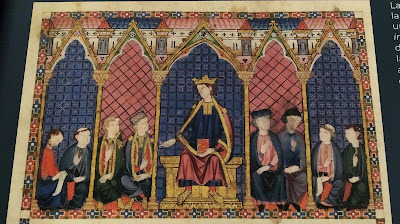 Display of the presentation miniature from a History of Spain codex from about 1280. The king tells his historians what to write and points to his heir, Sancho, who will become Sancho IV.
Display of the presentation miniature from a History of Spain codex from about 1280. The king tells his historians what to write and points to his heir, Sancho, who will become Sancho IV. 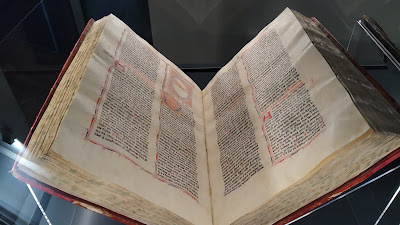 The General History was meant to be a history of the world from ancient times to the thirteenth century (their present day), but only made it to the first century AD before Alfonso's death cut the project short. This massive codex is from the royal scriptorium, about 1270, and is only the first part.
The General History was meant to be a history of the world from ancient times to the thirteenth century (their present day), but only made it to the first century AD before Alfonso's death cut the project short. This massive codex is from the royal scriptorium, about 1270, and is only the first part. A closeup of the beautifully legible text (you can't become learned if you can't read the texts) about the lineages of Jacob, General History.
A closeup of the beautifully legible text (you can't become learned if you can't read the texts) about the lineages of Jacob, General History.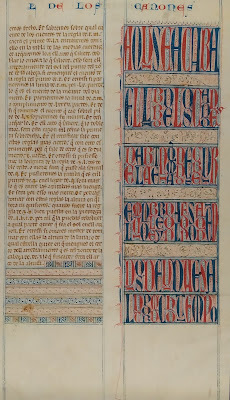 Display of the beautiful colophon of the Book of the Canons, an astronomy treatise. The red and blue part reads, "Here ends the book of the canons the most noble King Don Alfonso ordered to be written. May God grant him life and good health for a long time."
Display of the beautiful colophon of the Book of the Canons, an astronomy treatise. The red and blue part reads, "Here ends the book of the canons the most noble King Don Alfonso ordered to be written. May God grant him life and good health for a long time."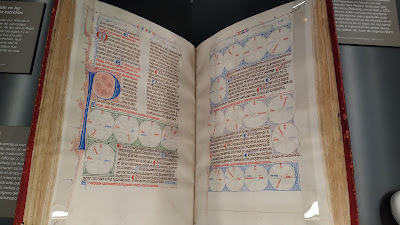 The Book of the Crosses, an astrology treatise from 1259, signed by its translators, Yehuda ben Mose ha-Kohen and Juan de Aspa.
The Book of the Crosses, an astrology treatise from 1259, signed by its translators, Yehuda ben Mose ha-Kohen and Juan de Aspa.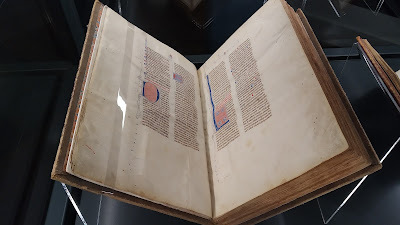 The Complete Book on Scrutiny of the Stars, about 1254.
The Complete Book on Scrutiny of the Stars, about 1254.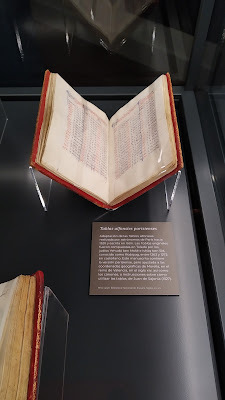 The Tablas Alfonsies were astronomical measurements taken at Toledo for Alfonso X between 1263 and 1274, and were used by scholars all over the known world for hundreds of years thereafter. This manuscript is from Paris, about 1320.
The Tablas Alfonsies were astronomical measurements taken at Toledo for Alfonso X between 1263 and 1274, and were used by scholars all over the known world for hundreds of years thereafter. This manuscript is from Paris, about 1320.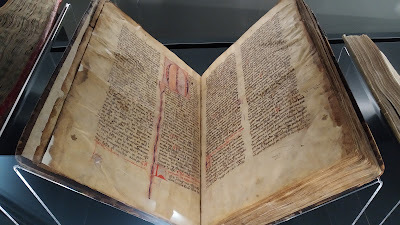
A History of Spain from the beginning of the fourteenth century (after Alfonso's death).
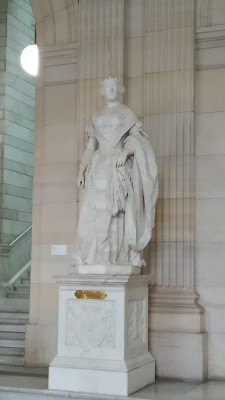 Finally, a feminine touch: Queen Isabel II, who helped found the National Library.
Finally, a feminine touch: Queen Isabel II, who helped found the National Library. 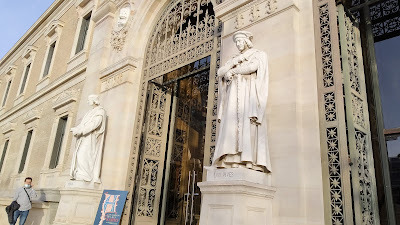 Out front, twentieth-century statues of the greats of Spanish literature. Here, Vives (father of psychology) and Nebrija (who wrote the first Spanish dictionary, 1492).
Out front, twentieth-century statues of the greats of Spanish literature. Here, Vives (father of psychology) and Nebrija (who wrote the first Spanish dictionary, 1492). 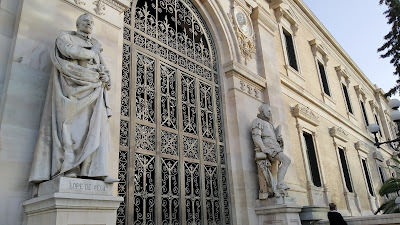 Lope de Vega and Miguel de Cervantes, who I suppose don't need further introduction.
Lope de Vega and Miguel de Cervantes, who I suppose don't need further introduction. 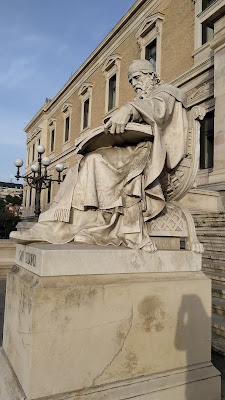 Isidore of Seville, a Visigoth (c. 560 - 636) who takes pride of place here because he wrote Latin Etymologies that have been an important reference ever since.
Isidore of Seville, a Visigoth (c. 560 - 636) who takes pride of place here because he wrote Latin Etymologies that have been an important reference ever since.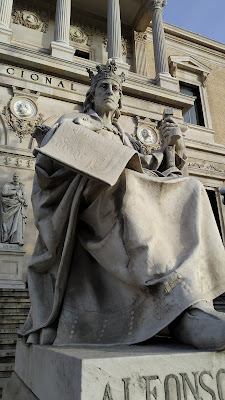 And the star of all learning, Alfonso X, el Sabio.
And the star of all learning, Alfonso X, el Sabio.
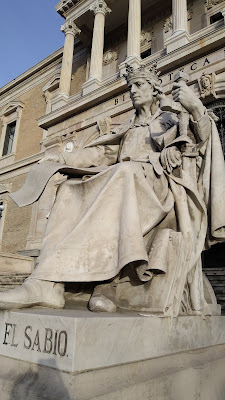 This statue exercises a particular attraction on this book nerd. In his hand, he holds a sheet from the Siete Partidas. It was probably hard to decide which branch of learning to represent with this medieval Renaissance man.
This statue exercises a particular attraction on this book nerd. In his hand, he holds a sheet from the Siete Partidas. It was probably hard to decide which branch of learning to represent with this medieval Renaissance man. 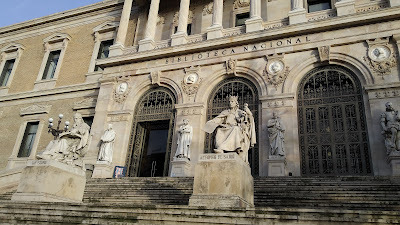
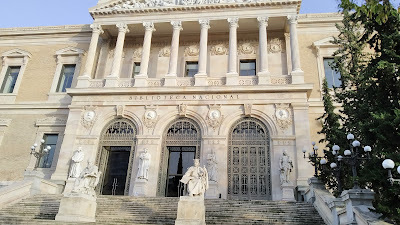
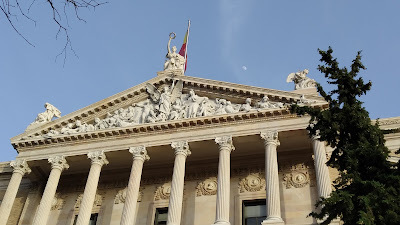
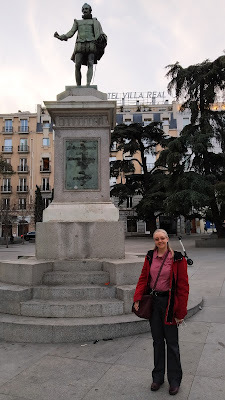 Mario and I walked back to where we'd parked through most of monumental Madrid. It's such a wonderful place to visit! Here I am with another statue of Cervantes across from the congress building.
Mario and I walked back to where we'd parked through most of monumental Madrid. It's such a wonderful place to visit! Here I am with another statue of Cervantes across from the congress building. 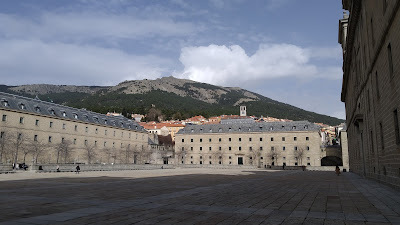 The very next morning, we headed to El Escorial in the mountains around Madrid for "Codices of the Wise King."
The very next morning, we headed to El Escorial in the mountains around Madrid for "Codices of the Wise King."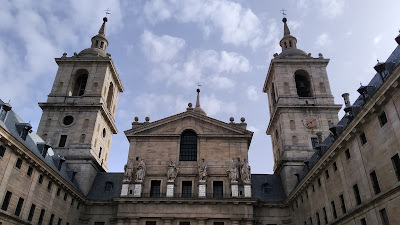 The monastery of El Escorial was built for Felipe II according to Neo-Classical architectural principles of reason, proportion, and balance. It has the most important manuscript library in Spain.
The monastery of El Escorial was built for Felipe II according to Neo-Classical architectural principles of reason, proportion, and balance. It has the most important manuscript library in Spain. 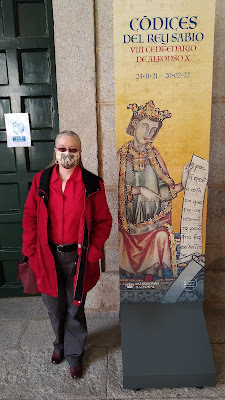 I liked that my mask had the same image on it!
I liked that my mask had the same image on it! 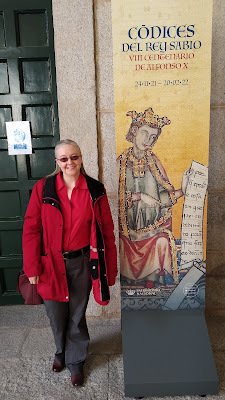 This exhibit was, if possible, even more mind-blowing because all the manuscripts were from the court of Alfonso X, books the king himself would have touched and marveled at (or possibly pointed out the flaws in), including the E and T codices of the Cantigas de Santa Maria, which obviously I have some affection for.
This exhibit was, if possible, even more mind-blowing because all the manuscripts were from the court of Alfonso X, books the king himself would have touched and marveled at (or possibly pointed out the flaws in), including the E and T codices of the Cantigas de Santa Maria, which obviously I have some affection for. In the beautiful library, a veritable temple of learning. Absolutely electrifying! But at the library of El Escorial, they never allow photos. So you'll have to take my word for it.
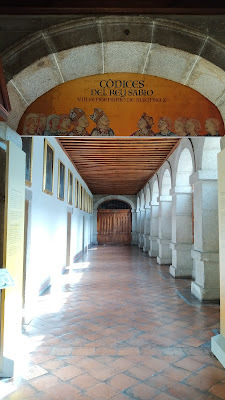 This was as close as I got before they started yelling not to take photos. I really think it should be apparent that I am not there to harm the books in any way, shape, or form.
This was as close as I got before they started yelling not to take photos. I really think it should be apparent that I am not there to harm the books in any way, shape, or form. I'd like to note that the ceiling of the library is painted with symbols of all the branches of learning. Alfonso X appears in the section for astronomy, with a tablet and an astrolabe.
Mario and I spent a good hour and half poring over the exhibit of nine manuscripts, so we got our money's worth.
The gift shop had many beautiful items with cantigas and Book of Chess designs on them, and of course I nabbed a few.
Back in the car, we decided on a strategy for lunch, and suddenly the whole couple of days came crashing down, and I sobbed with the emotion. Yes, it meant that much to me to see these books in person. With someone who encouraged my passion, no less.
I don't always weep with gratitude, but this occasion certainly merited it.
December 28, 2021
2021, An Alfonsine Year in Review
2021. At least it wasn't 2020, amirite?
I'm going to focus on positives in this post, as I do in real life. It's the best way forward, as I understand it.
In 2021, I found a couple of ongoing freelance editing jobs I'm satisfied with. I hope to continue for the foreseeable future with these companies, though freelancing is nothing if not unpredictable.
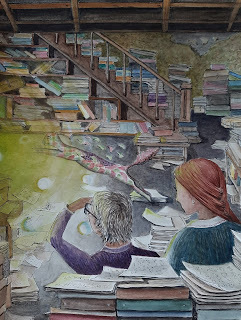 I published a work very particular and special to me,
The Atwells Avenue Anomaly
. If you're bored with predictable love stories or science fantasy, take a look at this deeply felt tale of the pursuit of happiness! I published only after collaborating with the ultra-talented Shirley MacKenzie, who prepared four unique illustrations. These appear in full color in both ebook and paperback.
I published a work very particular and special to me,
The Atwells Avenue Anomaly
. If you're bored with predictable love stories or science fantasy, take a look at this deeply felt tale of the pursuit of happiness! I published only after collaborating with the ultra-talented Shirley MacKenzie, who prepared four unique illustrations. These appear in full color in both ebook and paperback.
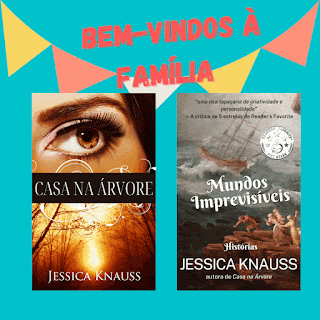 I was thrilled to welcome two Portuguese editions of my work into the world:
Casa na Árvore
and Mundos Imprevisíveis.
I was thrilled to welcome two Portuguese editions of my work into the world:
Casa na Árvore
and Mundos Imprevisíveis.Although those two events would be plenty for a normal year, for more than two decades, I've been waiting for 2021 to have a big blowout in honor of Alfonso X, el Sabio's, 800th birthday.
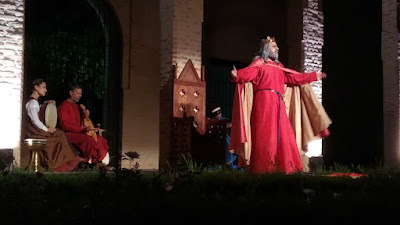 And so, I visited his favorite city, Sevilla, to see a play that integrated cantigas to tell the story of the last years of Alfonso X's life. It was thrilling to see the historical people I'm usually thinking about at any given moment embodied in living, breathing actors, and to hear the cantigas played with so much care and conviction.
And so, I visited his favorite city, Sevilla, to see a play that integrated cantigas to tell the story of the last years of Alfonso X's life. It was thrilling to see the historical people I'm usually thinking about at any given moment embodied in living, breathing actors, and to hear the cantigas played with so much care and conviction.
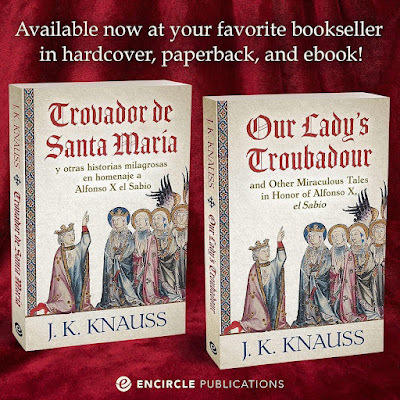 I published a beautifully designed book with Encircle Publications that I've had in mind for more than two decades:
Our Lady's Troubadour
, ten miraculously positive stories based on some of the Cantigas de Santa Maria. This has been my main tribute to the 800th birthday. It's the result of double the blood, sweat, and tears, because it came out on the same day in Spanish, the language Alfonso X worked so hard to establish as worthy of writing.
I published a beautifully designed book with Encircle Publications that I've had in mind for more than two decades:
Our Lady's Troubadour
, ten miraculously positive stories based on some of the Cantigas de Santa Maria. This has been my main tribute to the 800th birthday. It's the result of double the blood, sweat, and tears, because it came out on the same day in Spanish, the language Alfonso X worked so hard to establish as worthy of writing.
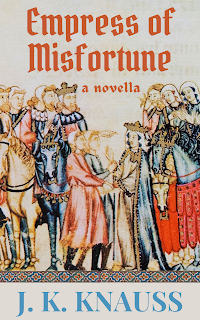 Once I got going on the stories, I couldn't resist writing an eleventh one. This one came out much longer because it's the "Byzantine novel" I've always anted to write. It tells the twisty-turny story of Beatriz, Empress of Rome, how for reasons beyond her control, she loses everything, and how she comes back from certain death to triumph because of her resilience and faith.
Empress of Misfortune
is available separately in digital formats, and I hope to have a paperback edition available in 2022.
Once I got going on the stories, I couldn't resist writing an eleventh one. This one came out much longer because it's the "Byzantine novel" I've always anted to write. It tells the twisty-turny story of Beatriz, Empress of Rome, how for reasons beyond her control, she loses everything, and how she comes back from certain death to triumph because of her resilience and faith.
Empress of Misfortune
is available separately in digital formats, and I hope to have a paperback edition available in 2022.
 I had a fun and fruitful interview with Dr. Debra J. H. Bolton of Kansas State University about the importance of Alfonso's legacy and the wonders of the Cantigas de Santa Maria. A transcript of the radio show is available here, and the full interview audio will become available very soon.
I had a fun and fruitful interview with Dr. Debra J. H. Bolton of Kansas State University about the importance of Alfonso's legacy and the wonders of the Cantigas de Santa Maria. A transcript of the radio show is available here, and the full interview audio will become available very soon.
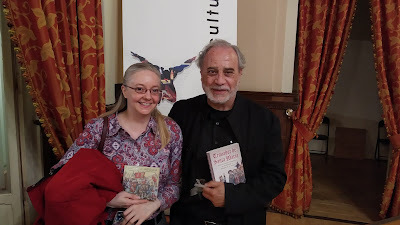 I also had a dream come true when I seized the opportunity to spend Alfonso X's 800th birthday, November 23, 2021, in Ciudad Real, where Eduardo Paniagua gave a concert with some members of Música Antigua, effectively bridging eight centuries so that the audience could feel what it was like to hear cantigas in the court of Alfonso X.
I also had a dream come true when I seized the opportunity to spend Alfonso X's 800th birthday, November 23, 2021, in Ciudad Real, where Eduardo Paniagua gave a concert with some members of Música Antigua, effectively bridging eight centuries so that the audience could feel what it was like to hear cantigas in the court of Alfonso X.
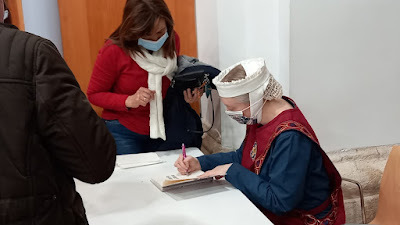 Signing (sold out!) books in ZamoraBecause Our Lady's Troubadour came out in Spanish, I was able to live out the dream of doing a book launch in Spain. The first event was in my home town of Zamora. It was an unbelievable, unique evening during which I got to see one of my aims for the book--for more people to hear about Alfonso X's wonderful works--come true right before my eyes. The musicians and I practiced for months beforehand, and the people of Zamora were incredibly welcoming of me and my little book!
Signing (sold out!) books in ZamoraBecause Our Lady's Troubadour came out in Spanish, I was able to live out the dream of doing a book launch in Spain. The first event was in my home town of Zamora. It was an unbelievable, unique evening during which I got to see one of my aims for the book--for more people to hear about Alfonso X's wonderful works--come true right before my eyes. The musicians and I practiced for months beforehand, and the people of Zamora were incredibly welcoming of me and my little book! It wasn't captured on video, but when I came out in my thirteenth-century costume that looked like I'd stepped right out of an Alfonsine manuscript painting, the audience was delighted and seemed unable to stop applauding. It created a wonderful sense of anticipation, and I think the evening delivered on that promise. The bookstore had never seen such a crowd and we didn't have enough copies of the book to meet the demand!
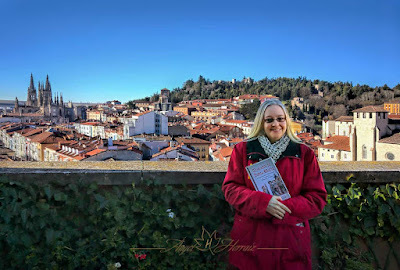 A week later, I did a completely different presentation in Burgos. I got to see my friend, Daniel, whom you know from this blog, after a year and a half. I have strong writerly ties to Burgos through Seven Noble Knights, and honestly, Burgos boasts more connections with Alfonso X than Zamora. After doing an interview at the local radio station, the host took me to place I hadn't seen before: the ruins of a monastery where it's said Alfonso's traitor brother Simon was buried. The stereotype of the cold Burgosian was further given the lie at the presentation. There weren't nearly as many people as in Zamora, but those who were there treated me like the greatest thing since sliced bread, and I'm more than satisfied.
A week later, I did a completely different presentation in Burgos. I got to see my friend, Daniel, whom you know from this blog, after a year and a half. I have strong writerly ties to Burgos through Seven Noble Knights, and honestly, Burgos boasts more connections with Alfonso X than Zamora. After doing an interview at the local radio station, the host took me to place I hadn't seen before: the ruins of a monastery where it's said Alfonso's traitor brother Simon was buried. The stereotype of the cold Burgosian was further given the lie at the presentation. There weren't nearly as many people as in Zamora, but those who were there treated me like the greatest thing since sliced bread, and I'm more than satisfied. In spite of how well they went, I lost money at these two events due to shipping costs and the requirements of the Spanish government for me to sell physical books legally. All for Alfonso!
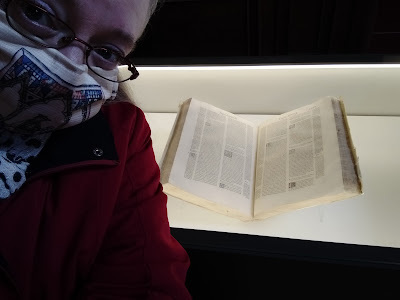 An awkward selfie with an early printed version of the Siete Partidas,
An awkward selfie with an early printed version of the Siete Partidas, which I studied extensively for Law and Order in Medieval Spain,
right there in Salamanca. Full circle. A last activity I was able to do in honor of 800 years of Alfonso X was to visit my old haunt, the University of Salamanca, to see a temporary exhibit of historical manuscripts. The trajectory illustrated the influences on Alfonsine historiography, actual Alfonsine manuscripts such as the Fuero Real and the Estoria de Espanna, and works about him by later generations as well as work directly influenced by the Alfonsine history workshop.
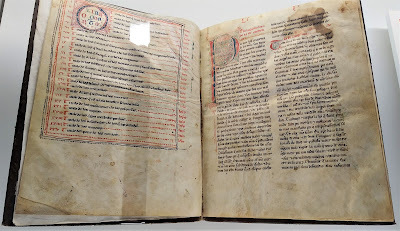 A thirteenth/fourteenth-century manuscript of the Fuero Real
A thirteenth/fourteenth-century manuscript of the Fuero Real
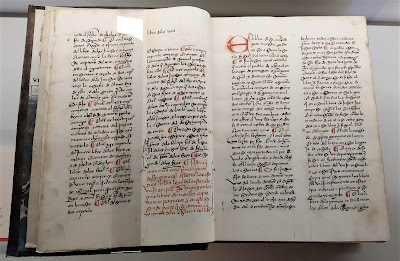 Fifteenth-century manuscript of Estoria de Espanna, part IV
Fifteenth-century manuscript of Estoria de Espanna, part IV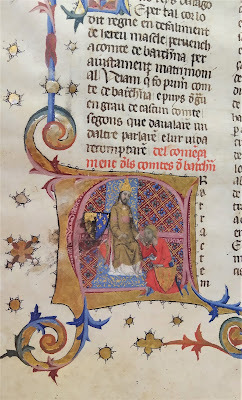 Detail from fourteenth-century
Detail from fourteenth-century Chronicle of the Kings of Aragon and Counts of Barcelona
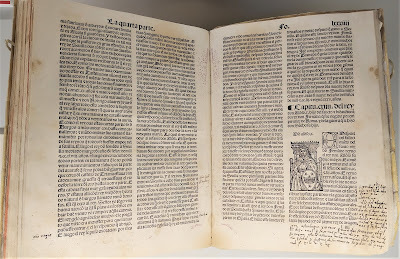 Chronicle of Spain by Diego de Valera, printed 1517,
Chronicle of Spain by Diego de Valera, printed 1517,with a note from a reader showing passionate interest in Alfonso X
One regret is that I haven't yet been able to get the Spanish translation of Law and Order in Medieval Spain out into the world before the end of 2021. It will come out sometime in 2022. Unlike King Alfonso, I do not have a team of translators, writers, and publishers working on my projects.
But, especially considering that the world was in the second year of a global pandemic and the healthcare, supply, and budget interruptions that accompanied it, 2021 has been replete with celebrations of different kinds, reflecting the wide variety of knowledge in Alfonso X's legacy.
It's 800 years later, and humanity is still dealing with issues of cross-cultural communication and acting without thinking. It's important to highlight Alfonso's ideals of accepting the contributions of all cultures and confronting challenges with considered wisdom and knowledge. If one additional person has been inspired to open their mind, I consider the main mission accomplished.
Happy new year!
November 25, 2021
How I Celebrated Alfonso X's 800th Birthday
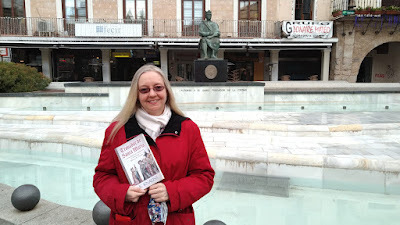 Showing the king my birthday present for him
Showing the king my birthday present for him All photos in this post 2021 Jessica Knauss
I've been looking forward to Alfonso X's 800th birthday on November 23, 2021, for a very long time: since before I moved to Spain, before so many things, before I went to study cantigas in England (of all places).
I was hoping to participate in lots of events for this grand occasion now that I live in Spain and could easily go to any one of Alfonso's favorite cities. Then the pandemic happened. I'd had Our Lady's Troubadour in the works for while, and thought since I can write a book under practically any circumstances, that it would be an apt tribute.
And so Our Lady's Troubadour came into being, with a lot of help from friends and Encircle Publications. But meanwhile, the conditions of the pandemic relaxed, and some conferences and theatrical experiences celebrating the 800 years started to take place. Mostly, I heard about them and sighed wistfully because travel is still difficult or because I heard about them too late to do anything.
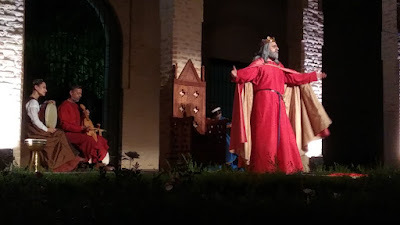 Jesús Lozano plays Alfonso X in Alfonso X: La última cantiga, Sevilla, August 2021
Jesús Lozano plays Alfonso X in Alfonso X: La última cantiga, Sevilla, August 2021 I was able to go to Sevilla for my own birthday and see the play La última cantiga, twice. It tells the story of the last years of Alfonso's reign and life and is punctuated by cantigas played by Cantica and Emilio Villalba (wonderful artists!). I know the history well, and to see it played out before my eyes was truly thrilling. Too few have been the times I've been to an event with cantigas played live. This is how they were meant to be enjoyed, in all their foot-tapping glory!
But that was my birthday. Was I going to spend Alfonso's great anniversary stuck at home among piles of my own books?
I didn't have to! I found out about Eduardo Paniagua doing a limited tour with the basic members of Música Antigua, ostensibly to promote their latest discs, about a month before the anniversary. With his group, Eduardo Paniagua has been recording all the Cantigas de Santa Maria, every last one of 427. They've been at it for about thirty years, and have some 380 done. The goal is on the horizon...
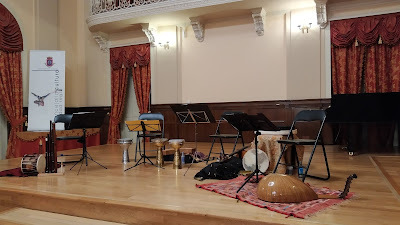 The closest thing you can get to the instruments of Alfonso's court.
The closest thing you can get to the instruments of Alfonso's court. The group uses instruments created from medieval miniatures and sculptures and a variety of voices and techniques. The approach they take, recording the entire text of each cantiga and developing the story with dialogue and interplay, has influenced my literary interpretation of the texts more than any single cantigas critic. Singing along with the recordings has helped me enter into the medieval mindset to write the stories in Our Lady's Troubadour , and given me a burning desire to perform cantigas in public (which I will do on December 10 if the worsening COVID figures don't stop me!).
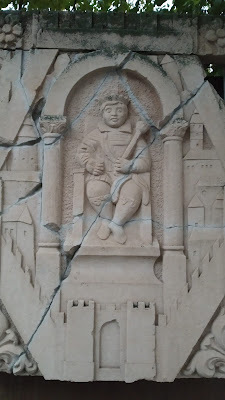 The city crest of Ciudad Real appears to feature Alfonso X!
The city crest of Ciudad Real appears to feature Alfonso X! I've been listening to Música Antigua's work since 1998. So when I found out that they were going to do a concert on November 23, the exact birthday, in Ciudad Real, which Alfonso founded (and where I'd meant to go and see a Manolo García concert in 2008, but that's another story), I leapt at the opportunity!

Ciudad Real isn't close to where I live. I reserved the Hotel Alfonso X, because how can you not, and tried to find out how to guarantee a seat when it was going to be first come, first served. I wrote to the cultural ministry, and at great personal cost, called, but never got to speak with the organizers. I had to just go and trust.
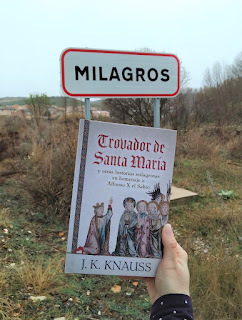 Another element of this story is that I have a shiny new boyfriend (shiny as in "knight in shining armor"), whom you will probably hear more about. His name is Mario, and when he suddenly got the opportunity, he offered to go to Ciudad Real with me, doing the driving. We had a delightful road trip to Don Quijote country through snow and sunshine. It was sleeting when we go to the town of Milagros in the mountains north of Madrid, and Mario took this photo showing a book of miracles in a town called Miracles so I could hold the umbrella and keep the book from getting wet. What a great guy!
Another element of this story is that I have a shiny new boyfriend (shiny as in "knight in shining armor"), whom you will probably hear more about. His name is Mario, and when he suddenly got the opportunity, he offered to go to Ciudad Real with me, doing the driving. We had a delightful road trip to Don Quijote country through snow and sunshine. It was sleeting when we go to the town of Milagros in the mountains north of Madrid, and Mario took this photo showing a book of miracles in a town called Miracles so I could hold the umbrella and keep the book from getting wet. What a great guy! 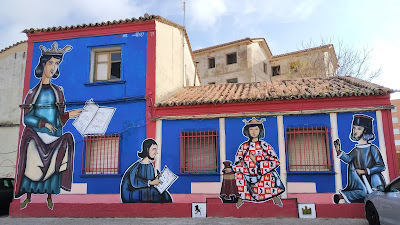
We toured Ciudad Real. It has a strong current of Don Quijote going on, less so of Alfonso X. The mural in the above photo was done last week, just in time for the 800th birthday. But I couldn't be stopped. We saw the mural, a couple of statues, and a fountain, and it was enough to keep me happy. I was coming full circle, finally seeing a concert in Ciudad Real--not Manolo, but Alfonso, and I was comparably excited.
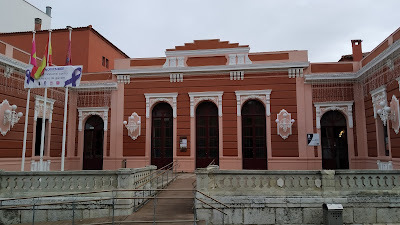 The old casino building
The old casino building In the morning, we headed to the concert venue, which is the headquarters of the cultural ministry in the old casino building. We wanted to see if they would guarantee us seats because we had come so far and, after all, I'd just published a book for Alfonso X. We met with the organizers, and my social ineptitude took over. I let Mario do the talking, but when he couldn't make a very strong case for us based on how far we'd traveled, he started explaining that I'm an Alfonso X expert. I took up the challenge finally when he said, "But she can explain it better than I."
I shakily removed Trovador de Santa Maria from the bag we'd been carrying around to protect it from the rain and explained that it had ten stories based on the plots of Cantigas de Santa Maria, and that I thought the City of Ciudad Real should have a copy. Everyone's demeanor changed. They said to come back when they opened the doors, and they would make sure we got in. (They didn't seem to feel the urgency I did about the limited number of seats.)
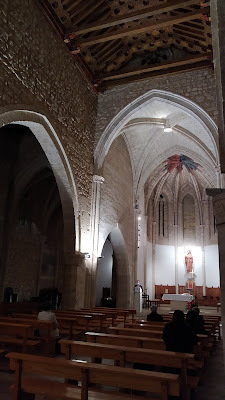 Santiago, the oldest church in Ciudad Real,
Santiago, the oldest church in Ciudad Real, might've seen Alfonso X cross its threshold. That done, we had a busy morning sightseeing, and all the while my mind was roiling with how the concert was going to go coupled with the excitement of hearing Cantigas live by the best musicians.
In the afternoon, I read the introduction of Trovador de Santa Maria to Mario, both to share with him the importance of this occasion and to get used to speaking about these things I so love. He suggested we go to the Plaza Mayor and read the introduction out loud at the fountain with Alfonso X's statue so he could hear his present. I wept copiously at the suggestion, thinking about all the years I've studied Alfonso X and how I wish I could know whether he likes my gift to him.
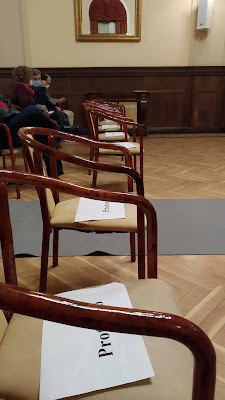 Front row, baby! We showed up at the casino early in our enthusiasm, and were told to come back later, not to worry, even if there were no seats available, they'd make room. Even with that hint, I still didn't imagine what ended up happening: we were personally escorted to the section labeled "protocol" in the front row! We were joined by members of the press and the organizers.
Front row, baby! We showed up at the casino early in our enthusiasm, and were told to come back later, not to worry, even if there were no seats available, they'd make room. Even with that hint, I still didn't imagine what ended up happening: we were personally escorted to the section labeled "protocol" in the front row! We were joined by members of the press and the organizers. Oh, the anticipation! The instruments were laid out as in the photo near the top of this post, and the air seemed to spark as, indeed, every last seat filled in behind us.
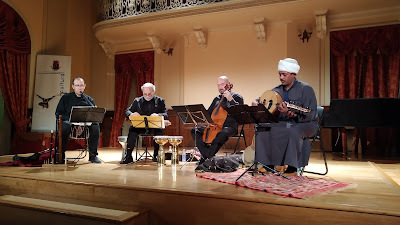
And then, Wafir Sheik, Luis Antonio Muñoz, Eduardo Paniagua, and Jaime Muñoz walked out and took their seats to play instrumental versions of Cantigas 388 (295) and 1. The sound, without amplifiers of any kind, was as perfect as on the discs, but so much more alive. It was like lifting a veil and opening a passageway to a thirteenth century full of richness and beauty.
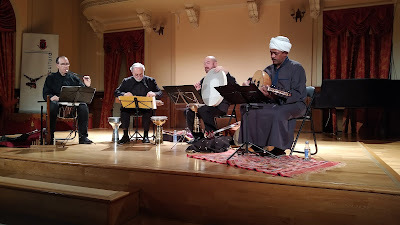
I knew most of the cantigas in the concert well. They're like old friends, and I couldn't help tapping my feet and mouthing the words as I stared unabashedly at the wonders taking place in front of me. Mario was also overcome with the masterful playing of the marvelous instruments. The photos don't do it justice. Videos wouldn't have, either.
Eduardo Paniagua talked with the audience between cantigas. He explained the miracles and their context, his perceptions of Alfonso's contribution to world culture, and how moved he was to be playing cantigas in Ciudad Real on November 23, 2021. I'd seen interviews with him before, and he always struck me as a very practical, no-nonsense kind of guy. But you can't be strictly practical and head a project of this magnitude for thirty years. Perhaps he's both down-to-earth and unbelievably passionate about this best of all medieval books, rather like I imagine Alfonso X himself.
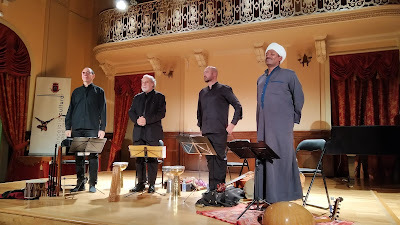
Afterward, they had discs for sale and the musicians stayed to chat with any audience member who wished to ask about the instruments or cantigas. I stood, my knees like jelly, my brain mush, and couldn't force myself to get in line to talk to Eduardo Paniagua just yet. Mario seized the opportunity to chat with Jaime Muñoz about the various flutes. While participating in that conversation, I also observed the others interacting with everyone and got the sensation that everyone in that large room loved cantigas and treated each other with kindness and respect because of that mutual understanding.
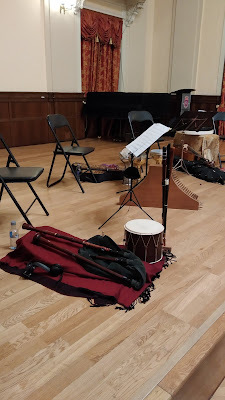 Rather than calming me down, that rush of love wound me up more. When it was finally my turn to talk to Eduardo Paniagua, I could only start by buying the latest two discs, which are in fact two-disc sets. But then somehow I managed to say my fangirl speech about how I think the cantigas project is the best project in the world and how I've been listening for twenty years, and being able to listen to the music has influenced my writing.
Rather than calming me down, that rush of love wound me up more. When it was finally my turn to talk to Eduardo Paniagua, I could only start by buying the latest two discs, which are in fact two-disc sets. But then somehow I managed to say my fangirl speech about how I think the cantigas project is the best project in the world and how I've been listening for twenty years, and being able to listen to the music has influenced my writing. Luckily, Eduardo then asked me what I write. I accepted Trovador de Santa Maria from Mario, and showing it to Eduardo, I explained that it's a book I wrote for the 800th anniversary, and that the short stories are based on the plots of cantigas. And that I would be honored if he accepted this copy. He was incredibly gracious, insisting I sign it and gifting me a triple-disc set in return. (So I'm seven discs richer in cantigas than before I went to Ciudad Real!)
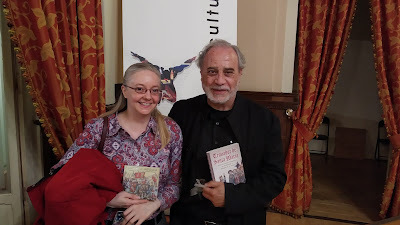 Two Alfonso enthusiasts exchange works of art.
Two Alfonso enthusiasts exchange works of art. Afterward, I went over to where Luis Antonio Muñoz, who did most of the singing, was showing the psaltery to a journalist, and told him (forgive my schmaltz), "Thank you for being the voice of Alfonso X." He was a very good sport about it and had a more-than-pleasant conversation with us. We were also able to congratulate Wafir Sheik on his excellent lute playing before we left.
A journalist overheard Mario and me talking with Luis Antonio Muñoz and came to ask us why we'd come so far to see a free concert. By then, I was warmed up, not to say on fire, and launched right into Trovador de Santa Maria . Look at the last paragraph of this article. I feel so proud looking at that! The organizers said they'd be in touch about a possible book event, too. A triumph all around.
I'm so grateful for these moments! I honestly don't know if I could've gone through with talking to everyone without Mario's encouragement. So I'm unspeakably grateful that he was able to come with me!
In the end, Alfonso X's 800th birthday was better than I could've imagined. Happy birthday!



